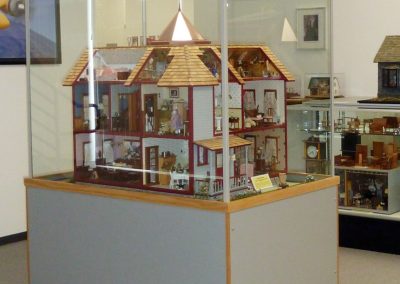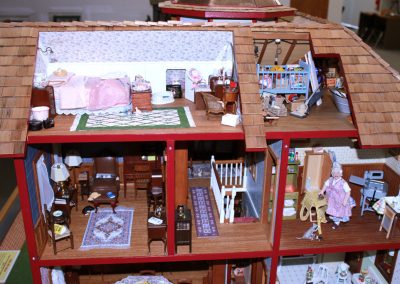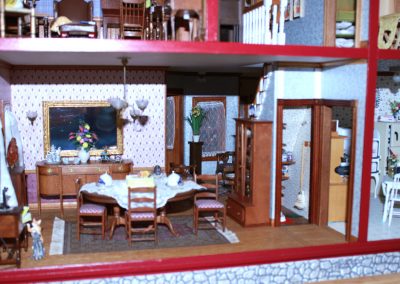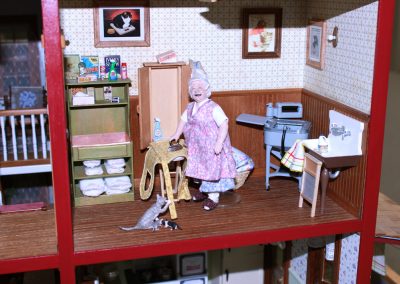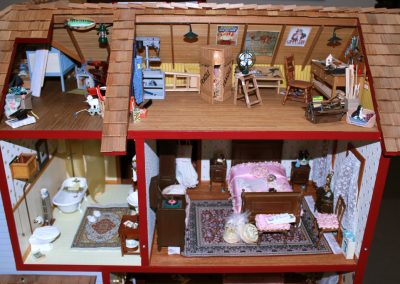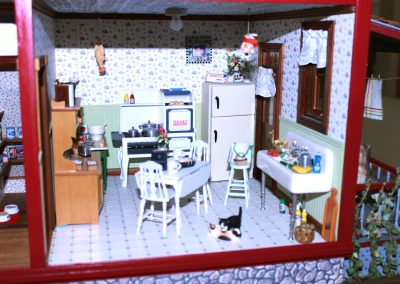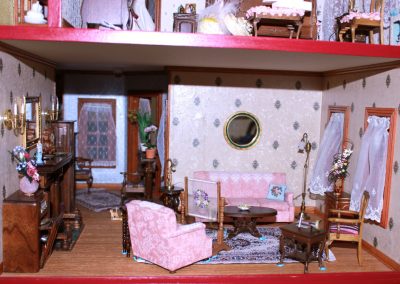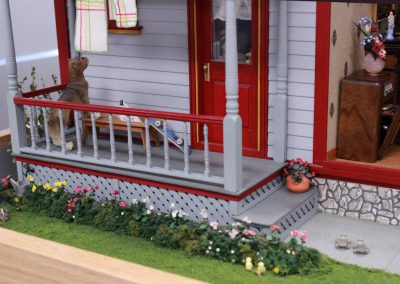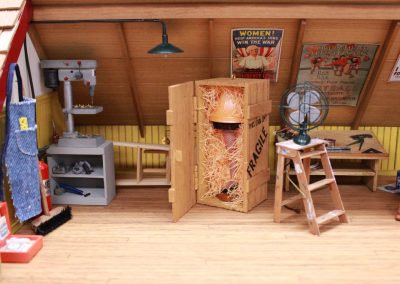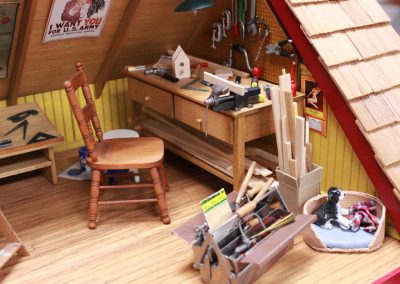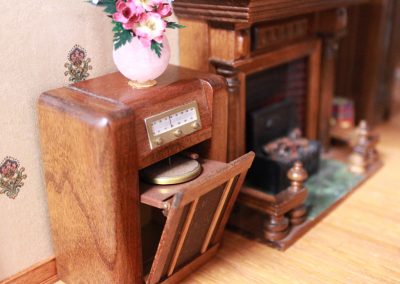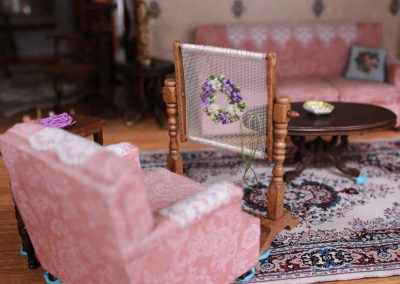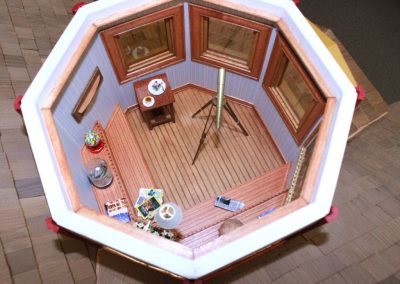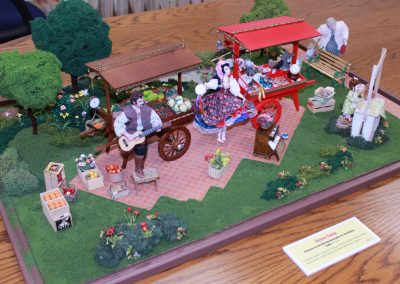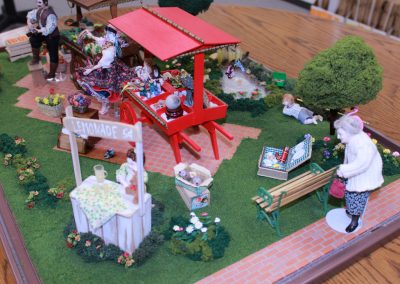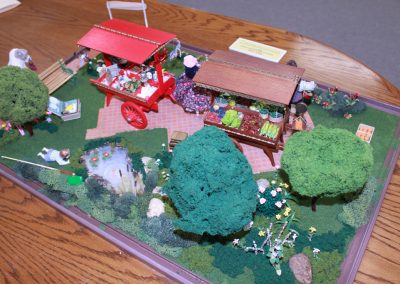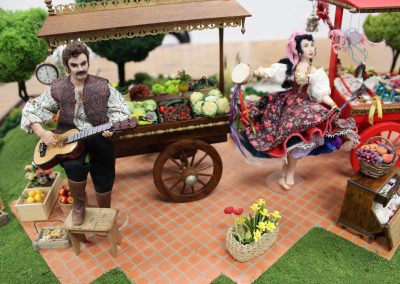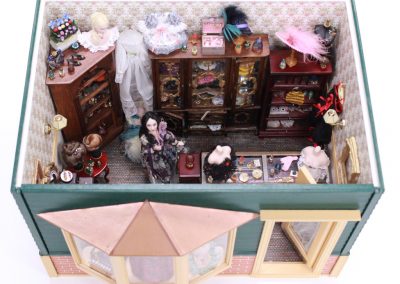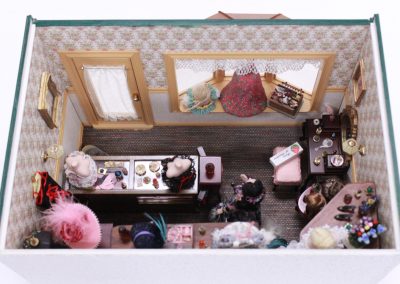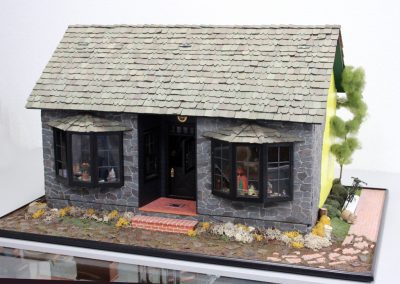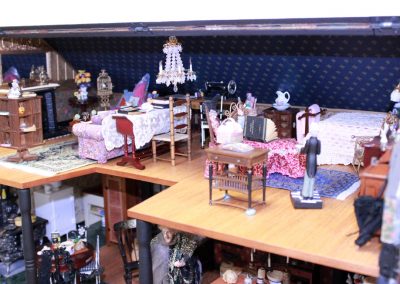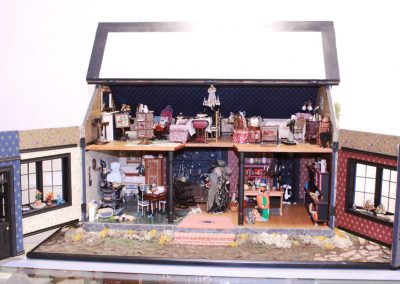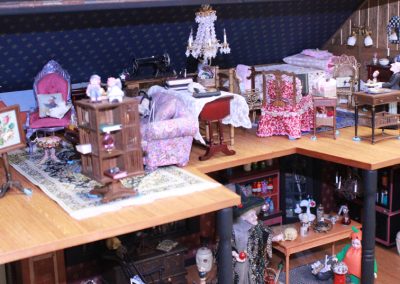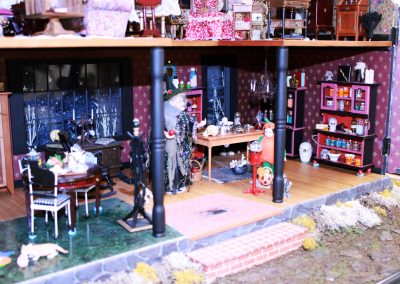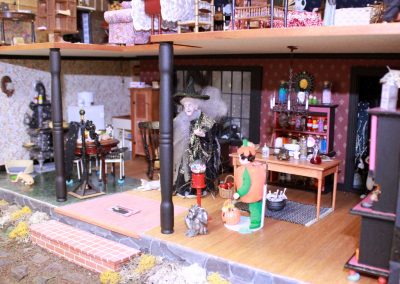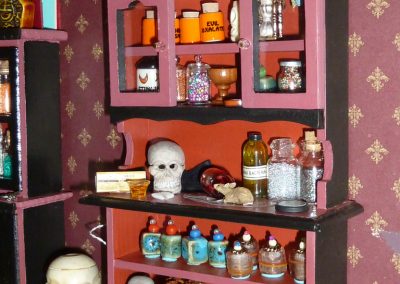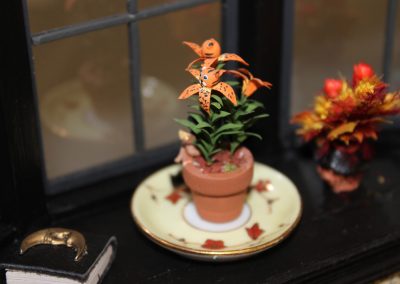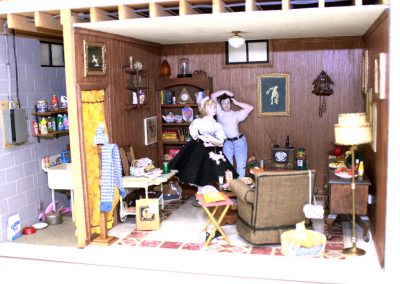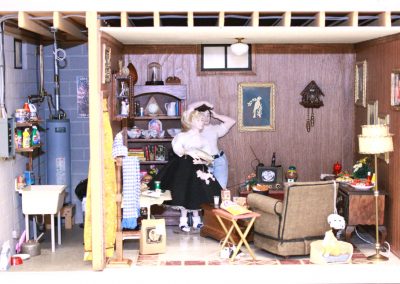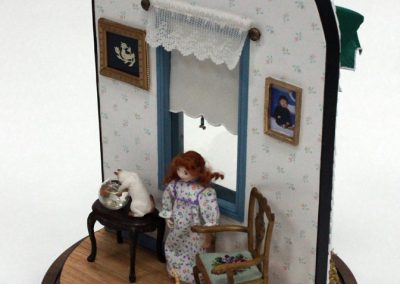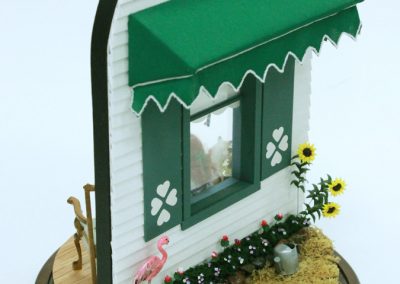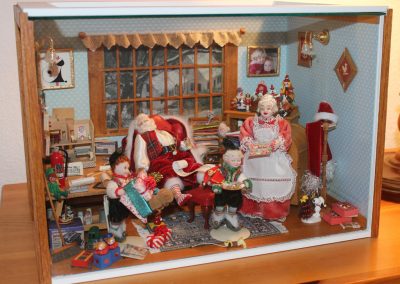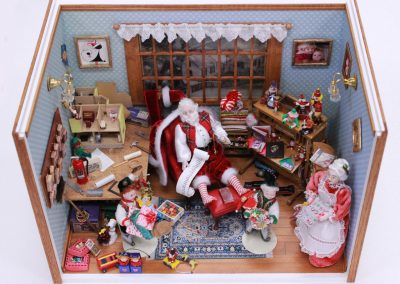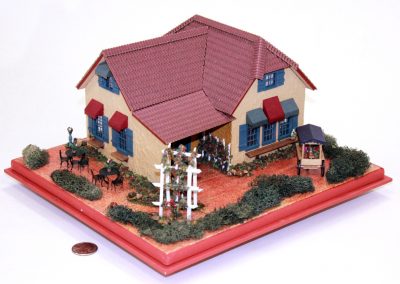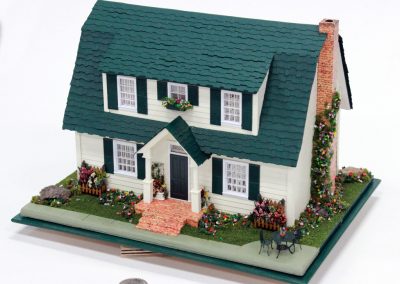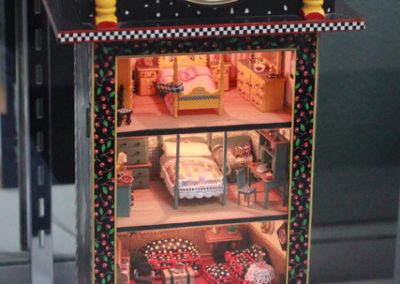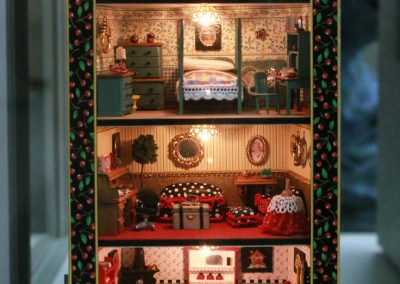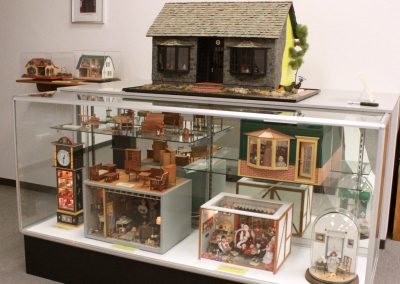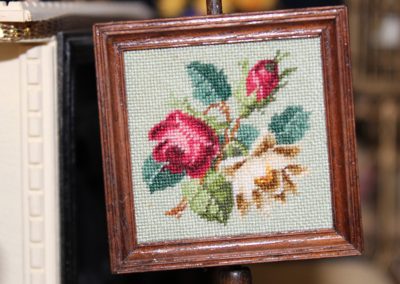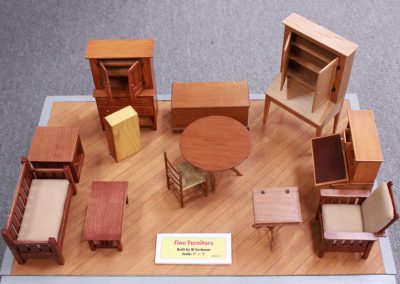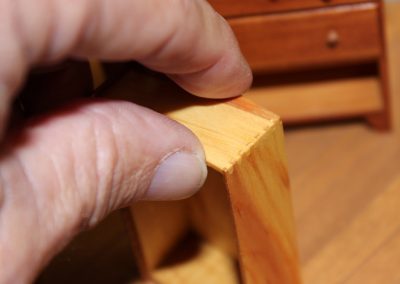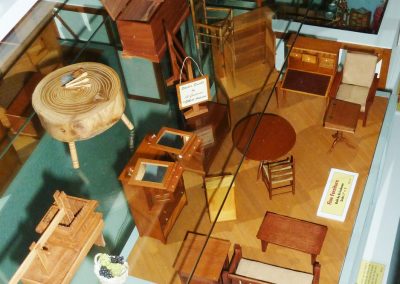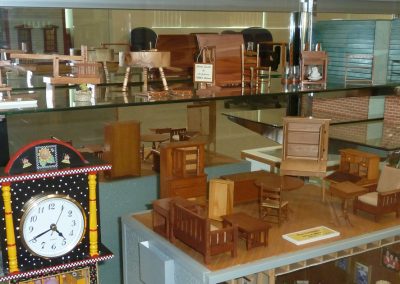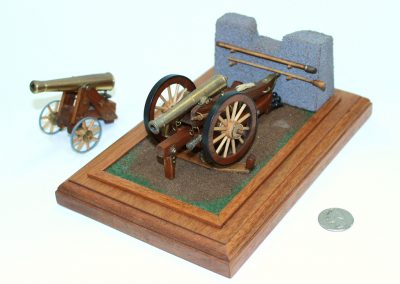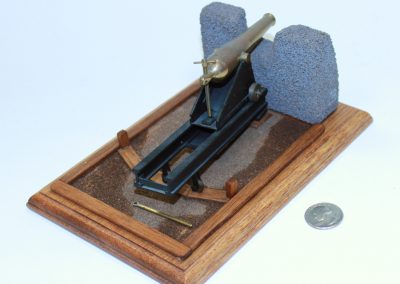Below you can view more photos of the Harings’ detailed miniature dollhouses. Click on images to enlarge. Additionally, for each respective model we have also included information on the many different people who contributed to these projects (aside from the Harings), and what pieces they made. All dollhouse photos are from Craig Libuse.
Miniature Dollhouses and Rooms at 1”:1’ Scale
1930’s-1940’s Dollhouse
This photo shows the Craftsmanship Museum’s custom-built display case for the house, which was made by Paul Healy. For the front porch, the paper flowers in pots were made by Kathy Meagher, but the flowers in pots on the sidewalk were made by Debby Noland.
1930’s-1940’s Dollhouse
The following photos show the abundance of detail in each individual room of this dollhouse. For the attic bedroom: the furniture was made by Bob Carlisle; the petit point art on the bench is from Jo Berbiglia; the wicker pet bed and crochet hat were made by Alice Buerkle; and the light is from Marie Toner.
Dollhouse Dining Room
For the dining room: the chairs and china cabinet were from Al Cushman; the petit point art on the chairs was done by Jo Berbiglia; the lights and chandelier are from Marie Toner; the telephone, phone bench, and floor radio were all made by Bob Carlisle; and the paper flowers were from Kathy Meagher.
Dollhouse Laundry Room
The porcelain doll in this laundry room was made by Fern Vasi. Can you count how many cats there are in the house? (Hint: there are more than 15!)
Dollhouse Upstairs
In the upper hall: the bookcase, including three printed books (Kidnapped, The Pooh Story Book, Hansel and Gretel) were made by Barbara Rahab; the paper orchid was from Karl Blindheim; the light is from Marie Toner; and the petit point art in progress is from Jo Berbiglia. For the bathroom: Lights were made by Marie Toner; the shaving table is by Al Cushman; and the shower is from Hammer-N-Smith. For the bedroom: the sconces are from Marie Toner; the painting is from Kendall; and the paper flowers are from Kathy Meagher.
Dollhouse Kitchen
The paper flowers in vases were made by Kathy Meagher. The table, chairs, and kitchen stool were made by Bob Carlisle.
Dollhouse Living Room
For the living room: the paper flowers in vases are from Kathy Meagher; the side table and radio/record player were made by Bob Carlisle; the paper orchids are from Karl Blindheim; the sofa and chair are from Sally Hardy; and the petit point pillow, needlework in progress, and stool were all from Jo Berbiglia.
Dollhouse Porch
A close-up photo shows details like the skates and skateboard on the front porch. The porch now also features a bicycle and lawn mower, which are not shown in this photo. The back porch features paper hollyhocks made by Debbie Noland.
Dollhouse Attic Workshop
More details from the attic—do you notice an interesting movie prop here? The small details bring life to each room, which sometimes includes a touch of humor!
Dollhouse Record Player
This tiny radio/record player was made by Bob Carlisle. For the library: the magazine table, lamp, and radio were made by Bob Carlisle; and the desk was from Al Cushman.
Dollhouse Cupola
The tiny cupola features a table made by Al Cushman, and paper flowers from Kathy Meagher.
Miniature Gypsy Camp
You can’t call this a miniature dollhouse, as there is no house. Even so, the scene is packed with details, from singing and dancing gypsy dolls to two tiny hedgehogs in a fruit box.
Dress Shop Boutique
This tiny dress shop is packed with all the latest styles—from many years ago, of course.
Witch’s House
From the back side, the house is painted bright yellow, and looks cheery enough. But as you come around to the front door, things start to get a little spooky.
Witch’s House
For the upper level: the chandelier was made by Phyllis Nissen; the fireplace screen and petit point art on the chair and pillow are from Jo Berbiglia; the paper flowers in vases are from Kathy Meagher; the crocheted bedspread was made by Ronni Weatherall; and the butler doll is from Cindy Treadwell.
Witch’s House
Joe Haring built the witch’s house so that the roof tips up, and the front walls swing outward, displaying two sides of the witch’s life.
Witch’s House
Upstairs is the Witch’s well-cared for boudoir, filled with the more delicate things, and the comforts of home.
Witch’s House
Downstairs is the witch’s workshop, with vials of poison and potions on the shelves, and lighted skulls on the table. Also, notice the poor, hapless trick-or-treater in a pumpkin suit, being offered an apple by the witch herself.
Witch’s House
For the lower level: the candlestick on the chest, the sconces, and the chandelier were made by J. Getlan; the pie safe and witch’s work table are from Al Cushman; the welcome mat is from Jo Berbiglia; the paper “tiger lilies” were made by Alice Buerkle, the porcelain witch doll is from Fern Vasi; and the doll in pumpkin costume is from Blackfoot Daisy.
Witch’s Tiger Lilies
This photo shows a detail you might otherwise miss—the tiny flowers in the pot by the window are actually “tiger lilies.” Can you see the tiny tiger faces? Jan delighted in finding tiny details like this to decorate her scenes. You have to spend a long time inspecting these houses in detail to catch it all, and when you come back the next time you will see things you missed before.
1950’s Basement Recreation Room
For this model basement: the porcelain dolls were made by Fern Vasi; the paper flowers are from Kathy Meagher; the BBQ in the utility area, the saddle shoes, and the table were all made by Cindy Treadwell.
1950’s Basement Recreation Room
All the details from the 1950’s are here, from the poodle skirt to the tiny round TV screen playing “I Love Lucy.” Joe Haring put a lot of authentic detail into the utility room on the left, including: a laundry tub and cleaning products, a fuse box, a hot water heater, and copper pipes.
Child’s Room Vignette
This small scene still features a lot of detail. Notice the cat pestering the fish in the fishbowl, or the beautiful petit point work on the seat of the chair. The polymer clay doll was made by Alice Buerkle. The petit point art on the chair was by Jo Berbiglia.
Child’s Room Vignette
Outside is an awning over the window, and flowers planted along the wall below.
Miniature Dollhouses at 1/4”:1’ Scale
Mimi’s Cafe Dollhouse
The front side of the Mimi’s Cafe model. Joe put the base for this model on a rotating stand, so the viewer could turn it to see the whole thing. The front has finished walls, but the back has open walls for viewers to peek into the two stories.
French Colonial Home
Another small scale model on a rotating base. This two-story house features style and furnishings in the French Colonial manner.
Clock House
Who needs a house? This small wall clock has had the pendulum replaced by four rooms, one above the other. Note that the four-story clock house is fully lighted on each floor, with tiny bulbs and chandeliers.
Haring Dollhouses on Display
A display case at the Craftsmanship Museum houses many of the Haring’s smaller models, with the witch’s house on top. The big 1930’s-1940’s house and the gypsy camp model have their own display bases. A large selection of miniature furniture from Al Cushman is also on display, courtesy of donations by Jan Haring and Jo Berbiglia.
Furniture and Decorator Items
Note: These items were made by other craftsmen, and contributed to the great detail inside of the Haring’s model houses. For those interested, there is a craftsman’s guild just for people who build miniature items like the ones seen decorating these dollhouses. You can visit the International Guild of Miniature Artisans (IGMA) website. The guild offers a school in Maine where craftsmen can learn the techniques used in making miniature objects for the dollhouse collectible market.
Petit Point Fireplace Screen
This intricate artwork was done by Jo Berbiglia, along with most of the petit point work in the other models.
Al Cushman Furniture
This miniature furniture was made by Al Cushman, and donated by Jan Haring and Jo Berbiglia. Cushman was a popular maker of fine furniture for 1”:1’ scale dollhouse miniatures.
Cushman Drawer Detail
Note the finely built dresser drawer detail, showing the tiny dovetailed joints at the back of the drawer. This is a detail that can only be noticed by a close observer, but would be appreciated by woodworkers in any scale.
Al Cushman Furniture
Al’s miniature furniture pieces were donated to the Craftsmanship Museum by Jan Haring and Jo Berbiglia.
Cannon Models by Joe Haring
Cannon Models
In addition to the dollhouses, Joe also built models of cannons, including the three turned from brass shown here. This photo shows a couple of wheeled field artillery cannons.

